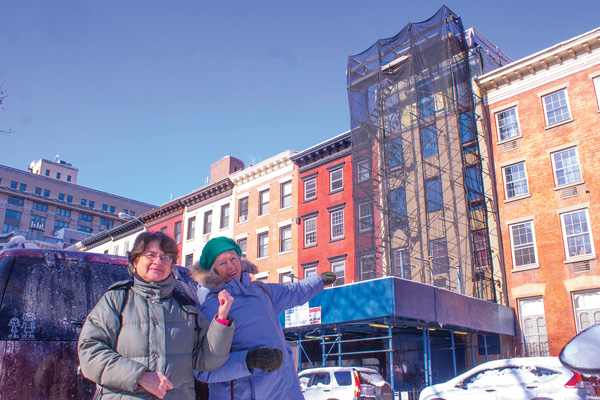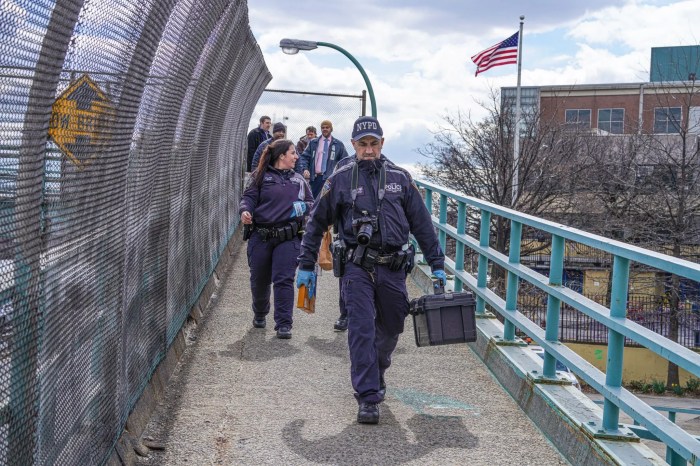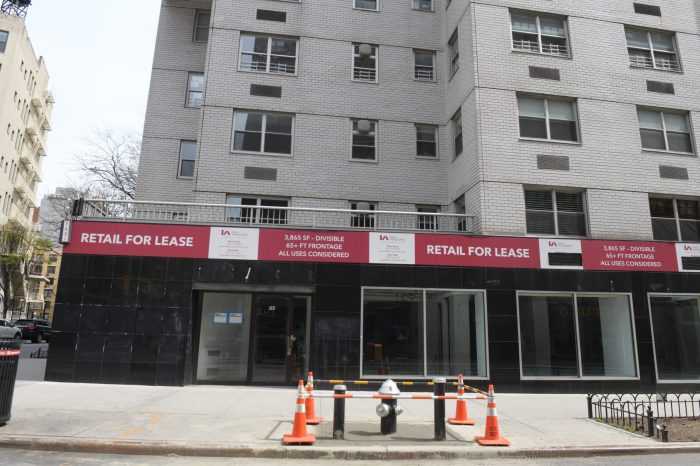
L to R: Fern Luskin and Julie Finch have battled Tony Mamounas, owner of the Hopper-Gibbons House, for years regarding a fifth story addition protruding above an historic roofline.
BY ZACH WILLIAMS | Preservationists scored a long-sought legal victory in an ongoing effort to restore Manhattan’s only documented and landmarked stop on the Underground Railroad back to its original height.
The appellate division of New York Supreme Court ruled on Feb. 24 that Tony Mamounas, owner of the Hopper-Gibbons House (339 W. 29th St.) would need approval from the city Landmarks Preservation Commission (LPC) in order to finish a fifth story. An attorney for a local group seeking to remove the building addition told Chelsea Now on Feb. 25 that the ruling allows for his clients to request that LPC order Mamounas to remove the alterations affecting the historical integrity of the building — a process that would take about six months.
“By doing so, we will preserve the heritage of what transpired there when it was used as an Underground Railroad station, when the members of the Hopper Gibbons family acted heroically to provide shelter to the slaves,” said Fern Luskin — lecturer of art and architectural history at LaGuardia Community College and a leader of the Friends of the Hopper-Gibbons Underground Railroad Site and Lamartine Place Historic District.
That organization along, with the city, acted as respondents in the case. A spokesperson for the city Law Department praised the ruling as “proper, rational and not arbitrary.”
Abigail Hopper Gibbons, a noted social reformer and outspoken abolitionist, lived there before and during the Civil War. Members of her family fled to safety across the roofs of buildings on what is now W. 29th St. after rioters looted the house and set it on fire during the July 1863 New York City Draft Riots.
In contrast to some controversies surrounding alterations to historic buildings, the roof rather than facade was particularly important in the case of the Hopper-Gibbons House because of the role it played in the riot and abolitionist movement. Escaped slaves from the South would visit the site on their way to freedom in Canada before and during the Civil War.
The case was not about the historical significance of the building, but rather an ambiguous permit regime, according to Marvin B. Mitzner, attorney for Mamounas.
“I think that the court really did not appreciate the nuance of this case,” Mitzner told Chelsea Now on Feb. 25. He added that he and his client have not yet decided on whether to appeal the latest ruling or to seek a permit through LPC in the future.
Mitzner argued in court on Feb. 4 that a 2005 permit from the city Department of Buildings (DOB) preceded the 2009 historical designation of the site. But DOB revoked that permit shortly before the designation following the discovery that only the city Board of Standards and Appeals (BSA) could waive provisions of the city Multiple Dwelling Law. Without such an exemption the renovations could not be made due to the building’s age.
That process was unclear when the original permit was secured, Mitzner argued. His client should be able to bypass LPC and apply directly to BSA to have the permit reinstated, he told the court.
But the appellate court instead upheld an Aug. 2013 ruling by Manhattan Supreme Court Judge Eileen Rackower.
“BSA’s (2013) determination that, in order to work at the site, petitioner was required to obtain the approval of the LPC, was rational and was not arbitrary and capricious,” the latest decision states.
The court did not agree with another argument from Mitzner that his client had “vested rights” in the case because his client did not have a valid permit at the time of historic designation.
Attorneys from both sides told Chelsea Now on Feb. 4 that they expected several months would pass before a judgment. The speed of the court in issuing a ruling on the case was a pleasant surprise to Mamounas’ legal opponents.
The ruling “sends a message to developers not to rely on illegally-issued permits and to respect the contours of the historic district,” said Jack L. Lester, attorney for Friends of Hopper-Gibbons, in a Feb. 25 telephone interview.
State Senator Brad Hoylman said in a statement that the ruling will help ensure the future integrity of the building and also “affirms the authority of the NYC Landmarks Preservation Commission and helps preserve an integral piece of American civil rights history.”
Hoylman, Councilmember Corey Johnson and state Assemblymember Richard Gottfried have supported the ongoing legal effort by helping with fundraising and publicity.
“The owner marred the building by illegally building a penthouse on the roof,” Johnson said in a statement. “The Supreme Court’s decision will help ensure that this historic building is restored to its original state and is a protected historic site in our community.”
Mamounas had a chance to boost his bottom line through historic tax credits, according to Gottfried. However a purported “vendetta against history” led the building owner to follow a different strategy, Gottfried said in a statement. He urged the LPC to not reinstate the permit and furthermore order Mamounas to restore the uniform roofline.
Recognizing the experience of African-Americans during the riots and slavery is a religious as well as historical cause for Julie Finch, another leader of Friends of Hopper-Gibbons who works closely with Luskin. The Hopper-Gibbons were Quakers like Finch who attends services at Fifteenth Street Monthly Meeting of the Religious Society of Friends (15 Rutherford Place).
The Quaker faith emphasizes social justice, fairness and individual initiative. In a time when racism once again features prominently in social discourse, the survival of the building at its original height would ensure a link between now and 150 years ago when one of the largest disruptions of civil order in United States history erupted on the streets of New York City, according to Finch.
“This can serve as a memorial to the eleven to 30 black men who were lynched in New York City by white Draft Rioting mobs,” Finch said in an email. “Thousands of black families fled this city, terrified of the three days of rioting.”

















